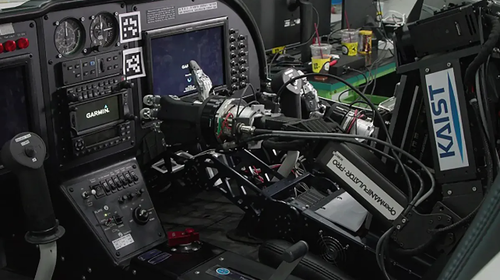AI Humanoid Pilot Might be Able To Solve Pilot Shortage
Our readers know there’s yet to be a quick solution to the US pilot shortage, which may linger until 2032. Current data shows a staggering 17,000-pilot gap. This shortfall can be attributed to several factors:
-
Early retirements spurred by the pandemic.
-
The unyielding retirement age of 65.
-
A dwindling number of pilots from the military.
-
The unappealing prospect for civilians to embark on a pilot career.
Airlines can only train 1,500 to 1,800 pilots a year. The deficit has triggered all sorts of flight disruptions, with the latest from American Airlines.
However, South Korean researchers from the Korea Advanced Institute of Science & Technology (KAIST) developed “Pibot,” a life-sized humanoid robot that can fly planes and understand complex flight controls.
Flight news website Airways Magazine explains more about Pibot’s capabilities:
As the world continues to adapt to the growing trend of Artificial Intelligence (AI), South Korean scientists have unveiled a humanoid robot capable of piloting an aircraft.
Named Pibot, the life-sized robot, measuring 160 cm tall and weighing in at 65 kg, is capable of gripping the controls, memorizing aircraft manuals, and even responding to emergency situations. It is fitted with multiple cameras capable of monitoring the aircraft’s systems and operational conditions.
Currently under development by the Korea Advanced Institute of Science & Technology (KAIST), researchers utilized Al chatbots such as ChatGPT to create ways for PiBot to learn the pilot manuals for various aircraft. The robot can then be changed onto an alternative airframe by clicking the type. It can also memorize worldwide Jeppesen aeronautical navigation charts, an impossible task for its human equivalent.
PiBot can also communicate with air traffic control (ATC) and other humans on the flight deck, meaning it can operate via a Captain or First Officer. This has been done using Voice synthesis. By plugging the robot into the aircraft, it can communicate directly with the airframe.
Airways Magazine explained the humanoid pilot has already demonstrated it can control an aircraft safely.
While it’s clear a robo-pilot is not something the US Federal Aviation Administration would clear anytime soon — it might catch the agency’s attention amid the worst pilot shortage ever.
US airlines have been quietly lobbying Congress to allow them to use just one pilot in the cockpit instead of two. But with an increasing number of pilot deaths — some even in mid-air — one has to wonder: Is the FAA open to considering a mix between human and robot pilots in the cockpit?
Tyler Durden
Fri, 08/25/2023 – 23:30
via ZeroHedge News https://ift.tt/l7hWNGP Tyler Durden
